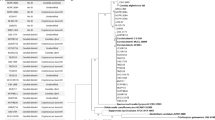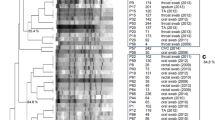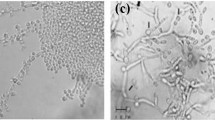Abstract
The majority of Candida species are known as non-pathogenic yeasts and rarely involved in human diseases. However, recently case reports of human infections caused by non-albicans Candida species have increased, mostly in immunocompromised hosts. Our study aimed to describe and characterize as thoroughly as possible, a new species of the Metschnikowia clade, named here Candida massiliensis (PMML0037), isolated from a clinical sample of human sputum. We targeted four discriminant genetic regions: “Internal Transcribed Spacers” of rRNA, D1/D2 domains (28S large subunit rRNA) and part of the genes encoding Translation Elongation Factor 1-α and β-tubulin2. The genetic data were compared to morphological characters, from scanning electron microscopy (TM 4000 Plus, SU5000), physiological, including the results of oxidation and assimilation tests of different carbon sources by the Biolog system, and chemical mapping by Energy-Dispersive X-ray Spectroscopy. Lastly, the in vitro antifungal susceptibility profile was performed using the E-test™ exponential gradient method. The multilocus analysis supported the genetic position of Candida massiliensis (PMML0037) as a new species of the Metschnikowia clade, and the phenotypic analysis highlighted its unique morphological and chemical profile when compared to the other Candida/Metschnikowia species included in the study.








Similar content being viewed by others
Data Availability
The Candida massiliensis holotype is available in the IHU MI (no. PMML0037) and IHEM (no. 28560) strain collections. The nucleotide sequences are available in GenBank (accession nos. OM952170 and OM952176). The datasets analysed in the current study are available from the corresponding author upon reasonable request.
References
Wang L, Chi Z, Yue L, Chi Z, Zhang D. Occurrence and diversity of Candida genus in marine environments. J Ocean Univ China. 2008;7:416–20.
Pfaller MA, Diekema DJ. Epidemiology of invasive candidiasis: a persistent public health problem. Clin Microbiol Rev. 2007;20:133–63.
Wisplinghoff H, Bischoff T, Tallent SM, Seifert H, Wenzel RP, Edmond MB. Nosocomial bloodstream infections in US hospitals: analysis of 24,179 cases from a prospective nationwide surveillance study. Clin Infect Dis. 2004;39:309–17.
Colombo AL, Nucci M, Park BJ, Nouér SA, Arthington-Skaggs B, da Matta DA, Warnock D, Morgan J. Epidemiology of candidemia in Brazil: a nationwide sentinel surveillance of candidemia in eleven medical centers. J Clin Microbiol. 2006;44:2816–23.
Vazquez JA, Sobel JD. Candidiasis. In: Dismukes WE, Pappas PG, Sobel JD, editors. Clinical mycology. New York: Oxford University Press; 2003. p. p143.
Pfaller MA, Diekema DJ. Twelve years of fluconazole in clinical practice: global trends in species distribution and fluconazole susceptibility of bloodstream isolates of Candida. Clin Microbiol Infect. 2004;10:11–23.
Trick WE, Fridkin SK, Edwards JR, Hajjeh RA, Gaynes RP. The national nosocomial infections surveillance system hospitals. Secular trend of hospital-acquired candidemia among intensive care unit patients in the United States during 1989–1999. Clin Infect Dis. 2002;35:627–30.
Hasejima N, Matsubayashi M, Kawabe R, Shimura C, Hijikata N, Oda T, Matsushima H, Kamei K. The first case of bloodstream infection by Candida Intermedia in Japan: the importance of molecular identification. J Infect Chemother. 2011;17:555–8.
Zumla A, Douglas M. Bennett’s principles and practice of infectious diseases. Lancet Infect Dis. 2010;10:303–4.
Pfaller MA, Boyken L, Hollis RJ, Kroeger J, Messer SA, Tendolkar S, Diekema DJ. In vitro susceptibility of invasive isolates of Candida Spp. to Anidulafungin, Caspofungin, and Micafungin: six years of global surveillance. J Clin Microbiol. 2008;46:150–6.
Nishikaku AS, Analy SA, Arnaldo L, Colombo M. Geographic trends in invasive candidiasis. Curr Fungal Infect Rep. 2010;4:210–8.
Morgan J, Martin I, Meltzer BD, Plikaytis AN, Sofair SH, Wilcox S, Harrison LH, Seaberg EC, Hajjeh RA, Teutsch SM. Excess mortality, hospital stay, and cost due to candidemia: a case-control study using data from population-based candidemia surveillance. Infect Control Hosp Epidemiol. 2005;26:540–7.
Burgos A, Theoklis E, Zaoutis C, Dvora JA, Hoffman KM, Knapp JJ, Nania PP, William JS. Pediatric invasive aspergillosis: a multicenter retrospective analysis of 139 contemporary cases. Pediatrics. 2008;121:1286–94.
Cantón E, Pemán J, Quindós G, Eraso E, Miranda-Zapico I, Álvarez M, Merino P. Prospective multicenter study of the epidemiology, molecular identification, and antifungal susceptibility of Candida Parapsilosis, Candida Orthopsilosis, and Candida Metapsilosis isolated from patients with candidemia. Antimicrob Agents Chemother. 2011;55:5590–6.
Brown GD, Denning DW, Gow NAR, Levitz SM, Netea MG, White TC. Hidden Killers: human fungal infections. Sci Transl Med 2012; 4 (165).
Wojtatowicz MJ, Juszczyk CP, Skiba A, Gdula A. Identification and biochemical characteristics of yeast microflora of Rokpol cheese. Int J Food Microbiol. 2001;69:135–40.
Dorko E, Kmťová M, Pilipčinec E, Bračoková I, Dorko F, Danko J, Tkáĉiková SE. Rare non-albicans Candida species detected in different clinical diagnoses. Folia Microbiol. 2000;45:364–8.
Melo N, Taguchi H, Jorge J, Pedro RJ, Almeida OP, Fukushima K, Nishimura K, Miyaji M. Oral Candida flora from Brazilian human immunodeficiency virus-infected patients in the highly active antiretroviral therapy era. Mem Inst Oswaldo Cruz. 2004;99:425–31.
Chen TC, Chen YH, Tsai JJ, Peng CF, Lu CF, Chang K, Hsieh HC, Chen HP. Epidemiologic analysis and antifungal susceptibility of Candida blood isolates in Southern Taiwan. J Microbiol Immunol Infect = Wei Mian Yu Gan Ran Za Zhi. 2005;38:200–10.
Burmeister HR, Hartman PA. Yeasts in ensiled high-moisture corn. Appl Microbiol. 1966;14:35–8.
Barrilli ET, Tadioto V, Milani LM, Deoti JR, Fogolari O, Müller C, Barros KO. Biochemical analysis of cellobiose catabolism in Candida Pseudointermedia strains isolated from rotten wood. Arch Microbiol. 2020;202:1729–39.
Cassagne C, Normand AN, L’Ollivier C, Ranque S, Piarroux R. Performance of MALDI-TOF MS platforms for fungal identification. Mycoses. 2016;59:90–678.
Normand AC, Cassagne C, Gautier M, Becker P, Ranque S, Hendrickx M, Piarroux R. Decision criteria for MALDI-TOF MS-based identification of filamentous fungi using commercial and in-house reference databases. BMC Microbiol. 2017;17:1–25.
Clinical and Laboratory Standards Institute. Reference Method for Broth Dilution Antifungal Susceptibility Testing of Yeasts, approved standard, 4th supplement, documentM27-S4.Wayne PA. 2012. Clinical and Laboratory Standards Institute.
Kabtani J, Militello M, Ranque S. Coniochaeta Massiliensis sp. nov. Isolated from a clinical sample. J Fungi. 2022;8:999.
Tamura K, Stecher G, Kumar S. MEGA11: molecular evolutionary genetics analysis version 11. Edited by Fabia Ursula Battistuzzi. Mol Biol Evol. 2021;38:3022–7.
Ruan SY, Chien JY, Hou YC, Hsueh P. Catheter-related fungemia caused by Candida Intermedia. Int J Infect Dis. 2004;14:147–9.
Taj-Aldeen SJ, AbdulWahab A, Kolecka A, Deshmukh A, Meis JF, Boekhout T. Uncommon opportunistic yeast bloodstream infections from Qatar. Med Mycol. 2014;52:552–6.
Nguyen TH, Nguyen VD. Characterization and Applications of Marine Microbial Enzymes in Biotechnology and Probiotics for Animal Health. In: Advances in Food and Nutrition Research. Elsevier; 2017, vol. 80, p. 37–74.
Paš M, Milačič R, Drašar K, Pollak K, Raspor P. Uptake of chromium(III) and chromium(VI) compounds in the yeast cell structure. Biometals. 2004;17:25–33.
Acknowledgements
The authors gratefully acknowledge wholehearted and fruitful discussions with Pierre Pontarotti concerning phylogenetic analysis and the technical support of Anthony Fontanini for electron microscopy investigations. We also sincerely thank Takashi Irie, Kyoko Imai, Shigeki Matsubara, Taku Sakazume, Toshihide Agemura, and the Hitachi team in Japan for the collaborative study conducted together with IHU Méditerranée Infection and for the installation of TM4000 Plus microscopes at the IHU Méditerranée Infection facility.
Funding
This research was funded by the Institut Hospitalo-Universitaire (IHU) Méditerranée Infection and by the French government under the “Investissements d’avenir” (Investments for the Future) programme managed by the Agence Nationale de la Recherche (ANR, fr: National Agency for Research), (reference: Méditerranée Infection 10-IAHU-03) and the Région Provence-Alpes-Côte d’Azur, European ERDF funding (European Regional Development Fund) and PRIMMI (Plateformes de Recherche et d’Innovation Mutualisées Méditerranée Infection).
Author information
Authors and Affiliations
Contributions
All authors contributed to the study conception and design. Material preparation, data collection and analysis were performed by JK, FB, and MM. The first draft of the manuscript was written by JK and all authors commented on previous versions of the manuscript. All authors read and approved the final manuscript.
Corresponding author
Ethics declarations
Conflict of interest
The authors have no potential competing interest to disclose.
Additional information
Handling Editor: Ferry Hagen.
Publisher's Note
Springer Nature remains neutral with regard to jurisdictional claims in published maps and institutional affiliations.
Rights and permissions
Springer Nature or its licensor (e.g. a society or other partner) holds exclusive rights to this article under a publishing agreement with the author(s) or other rightsholder(s); author self-archiving of the accepted manuscript version of this article is solely governed by the terms of such publishing agreement and applicable law.
About this article
Cite this article
Kabtani, J., Boulanouar, F., Militello, M. et al. Candida massiliensis sp. nov. Isolated from a Clinical Sample. Mycopathologia 188, 957–971 (2023). https://doi.org/10.1007/s11046-023-00792-4
Received:
Accepted:
Published:
Issue Date:
DOI: https://doi.org/10.1007/s11046-023-00792-4




